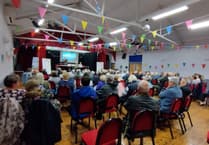The owners of a “landmark” award-winning house on top of a crumbling Criccieth cliff are seeking permission to save it from the effects of a landslip and erosion.
A planning application has been submitted to Gwynedd Council by the owners of Cefn Castell, near Llanystumdwy, seeking permission to carry out cliff stabilisation work, needed following a landslip due to water from a land drain as well as natural erosion.
The landslip occurred in February 2024, causing an “immediate threat” to the stability of the entrance to the house, with the boundary wall now overhanging the cliff.
Urgent remedial action is required to secure the entranceway to the house and the adjacent Welsh Coastal Path.
The application notes the cliff face at Cefn Castell is “prone to erosion and rockfalls” which poses “potential risk to the property, the coastline, and public safety”.
The well-known property was a winner of a national RIBA award, shortlisted for RIBA House of the Year, shortlisted as a national finalist in the LABC Awards and has been featured in many architectural magazines, journals and TV programmes.
It notably featured on Channel 4’s Grand Designs, which followed the house’s construction in 2014.
It has also become something of a local landmark and tourist destination, bringing visitors to the area after being let for 196 days in 2024.
The plans say it has “significantly contributed to the local economy”.
The property was originally designed by renowned Manchester architects Stephenson Studio for owners Rob and Kay Hodgson.
Its design was influenced by a maritime theme of coastal observation stations.
The proposed work will include stabilising the cliff to reduce an erosion risk, and provide long-term protection to adjacent land and property.
The design and access statement says the works “aim to address ongoing cliff erosion and enhance the structural integrity of the coastal slope at the site”.
The stabilisation scheme will primarily utilise rock nailing, gabions, and rock revetment, selected to ensure long-term protection against coastal erosion and provide a solution that integrates well with the surrounding landscape.
The cliff face at Cefn Castell, it says, is “prone to erosion and rockfalls, which pose a potential risk to the property, the coastline, and public safety”.
The stabilisation measures will minimise further erosion of the cliff face and reduce the risk of rockfalls and landslides that may impact the property or the Wales Coastal Path below.
The engineering solutions proposed include ‘rock nailing; the installation of high-tensile steel anchors driven into the cliff face to provide stability and reduce the risk of material slippage.
It would also use Gabion baskets – wire mesh cages filled with stone to form a retaining structure to support the slope and mitigate surface water erosion.
A ‘rock revetment’ a large armour of stones would be used at the base of the cliff to absorb wave energy and prevent further erosion.
Previous work, in 2015, when planning permission was granted, saw cliff stabilisation works using boulders to provide protection from sea erosion.
.jpeg?width=752&height=500&crop=752:500)



.jpeg?width=209&height=140&crop=209:145,smart&quality=75)
Comments
This article has no comments yet. Be the first to leave a comment.